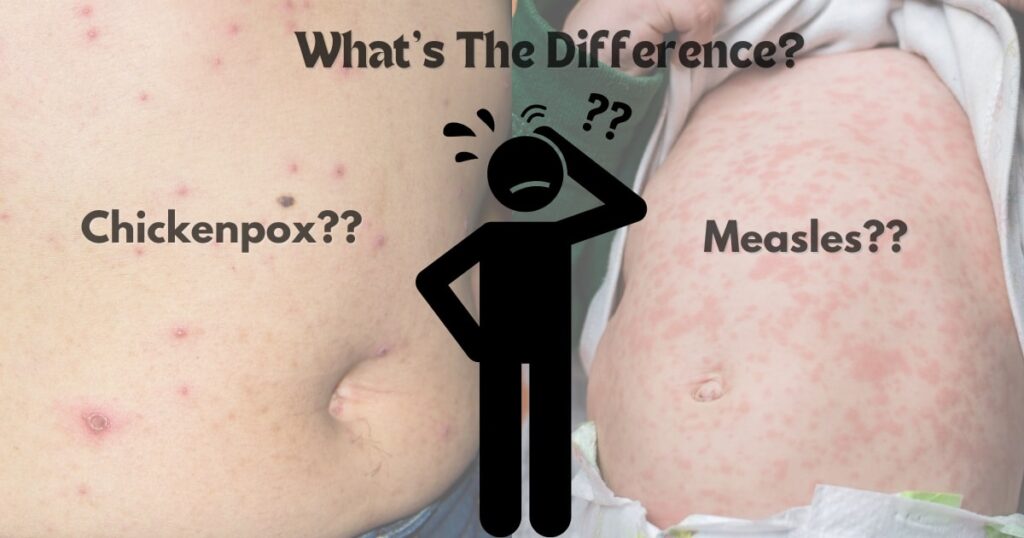Measles and chickenpox are among the most common, highly contagious viral infections, which occur mostly in children under 12 years of age.
As a parent, seeing your child endure chickenpox or measles can be tough to bear. If the symptoms have only begun, you may also feel a bit confused, as both infections start with almost similar symptoms—the red rash.
In this blog, we’ll walk you through the key differences between chickenpox and measles, talk about the prevalence and also discuss the steps you can take at home to help your child recover.
Note: The treatment strategy and at-home care tips apply to adults too. Having said that, let’s cut to the chase!
How Do Measles or Chickenpox Occur? Which Is More Prevalent?
Measles, also known as rubeola, is caused by the paramyxovirus, whereas chickenpox is caused by the varicella-zoster virus.
Both of these viruses spread when an infected person sneezes, coughs or directly touches a healthy person.
You can become infected if you inhale the respiratory droplets or touch an infected surface, object, or person.
Once the measles virus enters the body, it replicates and makes multiple copies. This is known as the incubation period lasting up to 10 to 14 days.
Similarly, the chickenpox virus remains in the body for 14 to 21 days before symptoms start. Both of these viruses are contagious even before symptoms begin.
Recent Stats on Prevalence of Measles vs Chickenpox in the United States
The number of chickenpox cases in the US has decreased exponentially since the introduction of the varicella vaccination program.
Conversely, the reports on measles cases are quite concerning. In 2000, measles was completely eliminated in the US. However, in 2019, almost 1300 cases were reported in 31 states of the US.
“And this year is even worse than 2019”, reports Dr. David Hamer, a professor of global health at Boston University, to NBC News. As of 1st August 2024, the CDC had confirmed almost 203 measles cases.
In comparison, there were only 4 outbreaks in 2023, whereas this year, a total of 13 outbreaks have been reported.
Public health officials attribute the increasing incidence of measles to the growing number of people who are not receiving vaccinations. This lack of vaccination can cause further outbreaks in unvaccinated populations. Therefore, strict surveillance is required to eliminate measles completely.
How Are The Symptoms Of Measles And Chicken Pox Different?

Although both conditions start with a rash and fever, once the symptoms progress, they are easily distinguishable.
The typical symptoms of measles start with high fever, cough, runny nose, red, and watery eyes (conjunctivitis). After 2-3 days, you may notice tiny, white spots (Koplik spots) inside the mouth.
As the days progress, the patient experiences a red and blotchy flat rash from the head towards the extremities which lasts about four days, and and then the recovery period begins.
On the contrary, with chicken pox, the symptoms start with flat, red, and itchy spots on the belly, back, or face. Gradually, they spread to all body parts, including the scalp, mouth, arms, hands, and lower extremities.
Within four days, you may notice the spots turn into fluid-filled blisters, also known as vesicles which may feel itchy, painful, and irritating.
Once the blisters or bumps rupture, scabs will form, and the recovery period begins. However, if your child scratches them, it might delay the scabbing process.
Some Common Treatment Options For Measles and Chickenpox
Since both measles and chickenpox are caused by a virus, the main objective of the healthcare provider or doctor is to ease the symptoms, such as fever, rash, or itchiness.
Therefore, your doctor may prescribe an antihistamine, such as Benadryl, to relieve inflammation. You can also apply topical lotions or creams to relieve the persistent itchiness or redness.
If the symptoms are severe or if you are at higher risk of complications, you may be advised to take antivirals to eliminate the virus from the body completely.
Some people who are at a higher risk of developing complications from chickenpox or measles include
- People with weak immune system
- Unvaccinated babies
- Adults who’ve never been vaccinated against chickenpox or measles
- People taking steroid medication
If you or your child are at a higher risk and have started developing any of the characteristic symptoms of measles or chickenpox, consult the healthcare provider without any delay.
5 Home Care Tips For Measles and Chicken Pox For Your Child
As a parent, you may be anxious when your child feels irritation and pain due to itchiness in the rashes. Here are five steps you can take at home to ease measles or chickenpox symptoms in your child:
- If your child has a fever, give over-the-counter fever-relieving medicines.
- Keep the fingernails clipped so the baby doesn’t scratch the infected areas. You can even put gloves on your baby’s hands.
- Use a cool compress or take cool baths to reduce the itchiness.
- You can also dab calamine lotion on itchy spots, avoiding the face and eyes.
- Make sure your child drinks plenty of fluids and juices.
Note: Do not give Aspirin (anti-inflammatory medicine) if your child is under 16 years of age unless advised by the doctor. This is because, during a viral illness, it can cause a brain disease known as Reye Syndrome.
Can I Prevent Chickenpox or Measles With Vaccines?
Yes! Both viral conditions can easily be prevented through vaccination. Even if you or your child is exposed to the virus in the future, you will have immunity against the virus.
Typically, the first dose of both vaccines is given between 12 and 15 months of age, while the second dose is given between 4 and 6 years.
If your child is not vaccinated and is over six years old, you can talk to the healthcare provider and schedule your vaccine visit.
Getting vaccinated not only protects your child from the infection but also helps prevent the spread of viral illnesses in the community.
Can Urgent Care Help Relieve Symptoms Of Measles or Chickenpox?
Yes! You can visit a nearby urgent care clinic or contact us if you live near Indiana or Illinois.
Our urgent care providers and doctors will evaluate your child’s symptoms, diagnose and provide a personalized treatment plan to ensure faster recovery.
We also make sure that, as a parent or a guardian, you receive proper counseling on managing the symptoms at home so that you know the steps to take if your child is experiencing severe discomfort, high fever, or persistent itching.
Not to mention, if the symptoms do not improve or you can’t come to the clinic, you can even book a video or phone appointment (telehealth) with the doctor and connect online.
Takeaway
In conclusion, chickenpox and measles begin as red rashes, but the location and appearance of the rash can tell whether your child is experiencing measles or chickenpox.
Whether the symptoms appear in an adult or a child, it is essential to contact a nearby doctor and receive proper treatment and care.
Although the number of cases of both diseases has been reduced in the United States due to high surveillance programs, unvaccinated people can reintroduce the virus and cause an outbreak.
If you or anyone in your family has not been vaccinated for measles or chickenpox, make sure to get vaccinated to reduce the spread of infections in the community.

